
Honey, Bees and Bee-friendly gardening!
Posted on 6 Sep 2021
Have you tried our Haygrove Honey?
Our more popular, runny honey is harvested weekly by our bee-man, Gareth. This honey comes from the hives in our raspberry fields. We also offer set honey, which comes from the strawberry hives, and is harvested around May.
Local honey is known to be beneficial for people suffering from hayfever, as it exposes a person to local pollen, and it tastes great!
But what about the bees?
Bees are not only very important for humans, but also for entire ecosystems to function. We all know that bees are pollinators for flowers, fruits and vegetables, and help them to reproduce. These plants make up the food system that feeds animals and humans!
However, Britain’s bees are in trouble. Did you know that we have already lost 13 bee species, and that an additional 35 species are under threat of extinction?
Using harmful pesticides, and shifts in weather patterns as a result of climate change are disrupting flowering times and the availability of food, shelter and nesting sites for bees. As well as this, a great number of honey bees across the world are suffering from colony collapse disorder, with the reasons unknown. These poor bees leave their hives, never to return, and it’s estimated that in some regions up to 90% of bees have disappeared.
Fortunately, there are plenty of simple and inexpensive things that we can do to make our outdoor spaces more bee-friendly. Here are just a few ideas!
- Make a bee garden! So many plants are bee-friendly. Whether a herb planter, flowers in a hanging basket, or trees, shrubs and larger plants in a bed. You don’t need a lot of space! Did you know that bees can see the colour purple clearer than any other colour? Planting lavender, alliums, and catmint are a great way to attract bees.
- Plant year-round, through all seasons. Remember to sow seeds for spring and summer plants in the winter, and to plant bulbs in the spring. Tip: Leave flowers to turn into seeds in autumn and winter, and let the birds feed on them!
- Let your grass grow! Leaving it a little longer in between cutting the grass gives pollinators shelter and a place to feed. Alternatively, you can raise the notches on the lawn mower, to lift the cutting blade a few centimetres higher.
- Avoid using bee-harming pesticides. As a general rule, we would suggest that you don’t use any pesticides around bees, however some that are safe for honey bees include garlic, herbicides and serenade. A great alternative to pesticides is to use a home-made bug trap!
- Order yourself a bee saver kit. Friends of the Earth provide one which contains wildflower seeds, a garden planner, a bee spotter, step-by-step guide, and more! It's a great place to start. Get yours here!
We would love to see your bee-friendly gardens! Tag us in your pictures and stories on Instagram by using our username @berriesunlocked.
